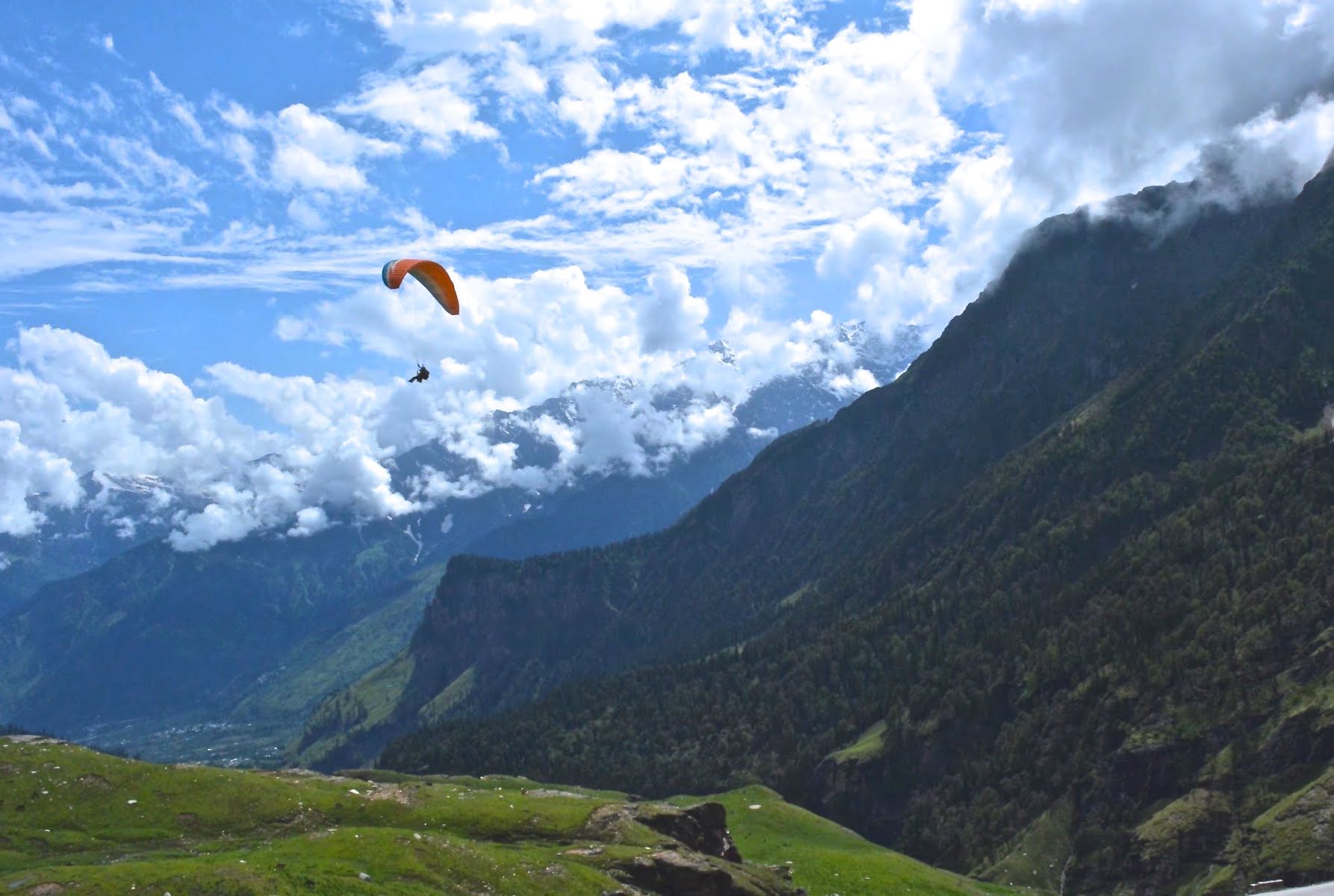 TravelINDIA.COM
TravelINDIA.COM
manali
spirit comes from new
experience into the wild
home page
Manali is named after the Sanatan Hindu lawgiver Manu. The name Manali is regarded as the derivative of 'Manu-Alaya'
which literally means 'the abode of Manu'. Legend has it that sage Manu stepped off his ark in Manali to recreate
human life after a great flood had deluged the world. Manali lies in the North of Kullu Valley. The valley is often
referred to as the 'Valley of the Gods'. Old Manali village has an ancient temple dedicated to sage Manu.
Manali is a resort town nestled in the mountains of the Indian state of Himachal Pradesh near the northern end of the
Kullu Valley, at an altitude of 2,050 m (6,726 ft) in the Beas River Valley. It is located in the Kullu district, about
270 km (168 mi) north of the state capital, Shimla, 309 km (192 miles) northeast of Chandigarh and 544 km (338 miles)
northeast of Delhi, the federal capital. The small town, with a population of 8,096,[1] is the beginning of an ancient
trade route to Ladakh and from there over the Karakoram Pass on to Yarkand and Khotan in the Tarim Basin. It is a popular
tourist destination and serves as the gateway to Lahaul and Spiti district as well as Leh.
Manali has witnessed a flurry of activity related to hydroelectric power and tourism. Unplanned and rampant construction
has led to severe depletion of forests and pollution of river bodies, along with garbage being disposed on the side of
the mountains. There has been a loss of habitat to various species of fauna, not limited to the Himalayan Monal,
incidentally the state bird of Himachal Pradesh. This prompted the National Green Tribunal to intervene and limit
vehicular movement on the popular Manali - Rohtang Pass highway, as well as Solang Valley. This has somewhat arrested
the damage. However, a lot still needs to be done.
Vashisht Temple, in Vashisht, Manali.
Manali is among top Indian skiing destinations.
History
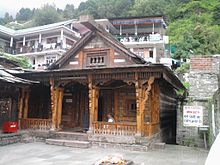 Manali is named after the Sanatan Hindu lawgiver Manu. The name Manali is regarded as the derivative of 'Manu-Alaya'
which literally means 'the abode of Manu'. Legend has it that sage Manu stepped off his ark in Manali to recreate human
life after a great flood had deluged the world.
Manali is named after the Sanatan Hindu lawgiver Manu. The name Manali is regarded as the derivative of 'Manu-Alaya'
which literally means 'the abode of Manu'. Legend has it that sage Manu stepped off his ark in Manali to recreate human
life after a great flood had deluged the world.
Manali lies in
the North of Kullu Valley. The valley is often referred to as the 'Valley of the Gods'. Old Manali village has an
ancient temple dedicated to sage Manu.
The British introduced apple trees in the area. The first apple orchard was set up by the British near Patlikuhl,
before this, no Apple trees grew in the area. To this day, apple— along with plum and pear— remain the best source
of income for the majority of inhabitants. Both Rainbow and Brown Trout was also introduced into the rivers and
streams of the area by the colonisers.
Before other luminaries started visiting Manali, India's first Prime Minister Jawaharlal Nehru favoured this as a holiday
destination in the mountains.[citation needed]
With the increase in disposable incomes and somewhat owing to the rise of disturbances in Kashmir in the late 1980s,
Manali witnessed a surge in tourist traffic. This once quiet village was transformed into a bustling town with numerous
homestays as well as the occasional boutique hotel. During the warmer summer months, cafes and restaurants can be seen
doing brisk business.
Culture
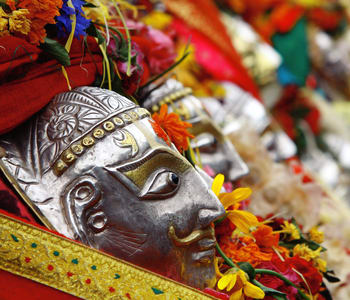
Manali has a unique diversity in its culture and rituals. The fairs and festivals celebrated in Manali are vibrant and carry a great economic and religious importance in the lives of the locals. They portray the innate traditionalism and highlight the rich cultural legacy of the bygone era. The cultural traits and ritualistic patterns have come down from the ancient times and become an integral part of the modern civilization as well. The rapid industrialisation has not affected their cultural traits. Manali is famous for its enchanting and melodious folk songs and indigenous folk dances. The place is also blessed with the rich traditional art and craft forms, from the ancient era.
The cultural aspects of Manali display the varied yet so enriched socio-cultural lifestyles of the locale.
Climate
The climate in Manali is predominantly cold during winter and moderately cool during summer. The temperatures range from 4 °C (39 °F) to 26 °C (79 °F) over the year. The average temperature during
summer is between 10 °C (50 °F) and 26 °C (79 °F), and between -15 °C (5 °F) and 12 °C (54 °F) in the winter.
Monthly precipitation varies between 31 mm (1.2 in) in November and 217 mm (8.5 in) in July. On average, some 45 mm (1.8 in) of precipitation is received during winter and spring months, increasing to some 115 mm (4.5 in) in summer as the monsoon approaches. The average total annual precipitation is 1,363 mm (53.7 in). Manali experiences snowfall
predominantly between December and beginning of March. The month of January is when it is usually the highest.

tourism
Hadimba temple
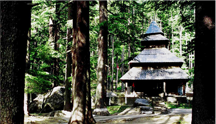 Manali has many attractions but the chief centre of interest, historically and archeologically, is undoubtedly the DHOONGRI TEMPLE dedicated to goddess Hidimba, the Bhim of Mahabharat fame. It has four-tiered Pagoda shaped roof and the doorway is carved with legendary figures and symbols. This temple located amidst wooden forest of deodar is about 2.5 Kms. from the tourist office. It is a pleasant experience to stroll in the temple complex which was built in 1533 A.D. A large festival is held here in May.
Manali has many attractions but the chief centre of interest, historically and archeologically, is undoubtedly the DHOONGRI TEMPLE dedicated to goddess Hidimba, the Bhim of Mahabharat fame. It has four-tiered Pagoda shaped roof and the doorway is carved with legendary figures and symbols. This temple located amidst wooden forest of deodar is about 2.5 Kms. from the tourist office. It is a pleasant experience to stroll in the temple complex which was built in 1533 A.D. A large festival is held here in May.
Jagat sukh
6 Kms. from Manali located on the left bank on Beas on the road to Naggar. The place is famous for very old temples of Lord Shiva and Sandhya Gayatri in Shikhara style, these are worth a visit.
Arjun Gufa 4Kms. from Manali towards Naggar, the cave is situated near Prini village 1Km. above the road where Arjun had meditated. This is good 1/2 a day excursion with charming view of the brilliant mountains.
Rohtang pass
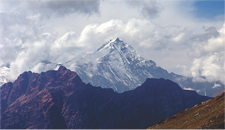 Rohtang Pass (3979 m) is 51Kms. from Manali on highway to Keylong/Leh. It offers a panorama and spectacular mountain view. The pass is open from June to October each year although trekkers can cross it earlier. It is a gateway to Lahaul Spiti, Pangi and Leh valley just as Zojila pass is a gatway to Ladakh. There are a beautiful sight of glaciers, peaks and Chandra river flows down in the Lahaul valley. Slightly to the left are the twin peaks of the Geypan. During summer(mid June to October) regular buses ply between Manali-Keylong/Darcha, Udaipur, Spiti and Leh. Rohtang Pass is best visitable between May/June to October/November. For latest information about opening of Rohtang Pass, contact tourist information centre at Manali, Ph: +91-1902-252175; 253531.
Rohtang Pass (3979 m) is 51Kms. from Manali on highway to Keylong/Leh. It offers a panorama and spectacular mountain view. The pass is open from June to October each year although trekkers can cross it earlier. It is a gateway to Lahaul Spiti, Pangi and Leh valley just as Zojila pass is a gatway to Ladakh. There are a beautiful sight of glaciers, peaks and Chandra river flows down in the Lahaul valley. Slightly to the left are the twin peaks of the Geypan. During summer(mid June to October) regular buses ply between Manali-Keylong/Darcha, Udaipur, Spiti and Leh. Rohtang Pass is best visitable between May/June to October/November. For latest information about opening of Rohtang Pass, contact tourist information centre at Manali, Ph: +91-1902-252175; 253531.
Rahala water falls
16 Kms. on way to Rohtang pass. If one goes to Marhi on foot from Kothi from the old road, the sight of the falls is fascinating. It is a good picnic spot as well.
Solang valley
 13 Kms. is a splendid valley between Solang village and Beas Kund. Solang valley offers the view of glaciers and snow capped mountains and peaks. It has fine ski slopes. The Mountaineering Institute has installed a ski lift for training purpose. Located here is a hut and guest house of the Mountaineering and Allied sports Institute, Manali. Now a few hotels have also come up. The winter skiing festival is organised here. Training in skiing is imparted at this place.
13 Kms. is a splendid valley between Solang village and Beas Kund. Solang valley offers the view of glaciers and snow capped mountains and peaks. It has fine ski slopes. The Mountaineering Institute has installed a ski lift for training purpose. Located here is a hut and guest house of the Mountaineering and Allied sports Institute, Manali. Now a few hotels have also come up. The winter skiing festival is organised here. Training in skiing is imparted at this place.
Nehru kund
5 Kms. on National Highway to Leh,a natural spring of cold clear water named after Pt. Jwahar Lal Nehru, who used to drink water from this spring during his stay in Manali. This spring is believed to originate from the Bhrigu lake situated high-up in the mountains.
Vashist hot water springs and templesVashist, a small village located on the left bank of river Beas towards Rohtang pass is worth a visit. It is renowned for its hot springs and temples. Nearby is the pyramidal stone temple dedicated to Vashist Muni. There is another Temple of Lord Ram here. Natural hot sulphur springs with two separate bathing tanks for gents and ladies are always full of tourists. Turkish style showers fitted baths have also been built nearby. Hot water from the nearby spring is provided for bathing.
Mountaineering Institute, Manali Located 3 Km on the left bank of river Beas towards Kullu, Atal Bihari Vajpayee Institute of Mountaineering and Allied Sports Manali, organises basic & advance training courses, in trekking, mountaineering, skiing and water sports. Skiing and trekking equipments can be hired from here by booking in advance. Tourists can visit an interesting showroom here.
For more details, please visit website of Atal Bihari Vajpayee Institute of Mountaineering and Allied Sports
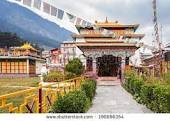
Tibetan monasteries
There are 3 newly constructed colorful monasteries, where visitors can buy carpets and other Tibetan handicrafts. Two are located in the town and one at Aleo on the left bank of Beas river.
Club house 2 Kms. from the town, club house has indoor games facilities which has been located on the left bank of Manalsu Nallah. There are some picnic spots near it.
Manu temple 3 Kms. from the main bazar in old Manali lies the temple of MANU RISHI. It is believed that this is the only temple of Manu in India, who was the creator of human race on the earth.
Kothi
Kothi is also called Koshtampi. It is little below Kalpa, and is overshadowed by the Kinner Kailash peak. The village with its attractive temple, gracious willows green fields, fruit trees makes an altogether lovely landscape. Goddess Shuwang Chandika temple is in the village

Great Himalayan National Park The National Park with an area of 754 sq. Km. is located in Kullu District and has the representative area of temperate and alpine forests of Himachal. It has some the virgin coniferous forests of the State. Vast areas of alpine pastures and glaciers cap this park. This area has many important wildlife species of Western Himalayas, like Musk deer, Brown bear, Goral, Thar, Leopard, Snow leopard, Bharal, Serow, Monal, Kalij, Koklas, Cheer, Tragopan, Snow cock etc. Trekking of Rakti-Sar, origin of Sainj river and camping in alpine pastures is unforgettable. Similar is the trekking route to Tirath the origin of Tirthan river. Visitors can contact Director, Great Himalayan National Park at Shamshi or Range Officer wildlife at Sainj or Range Officer Wild Life at Sai Ropa (Banjar) for assistance and guidance. Camping equipment and guides are provided by the Forests Department.
For more details, visit Great Himalayan National Park website
Manali sanctury This sanctuary starts about 2 Km from Manali town.
ItLeopard forms the catchment of Manalsu khad. A bridle path from Manali log huts/ Dhungri temple passes through
dense Deodar, Kail, Horse chestnut, Walnut and Maple forests. Night stay in tents at Lambadug or Gallant thatch is
an unforgettable experience. Alpine lush green pastures and glaciers beyond Galant thatch are a romantic attraction
for the enthusiastic but enduring visitors. One may see Musk deer, Monal and Brown bear digging or ploughing the
land and also pug marks with scent of Leopard or Snow leopard. Those who venture up to snows can see herds of Ibex in
the glacier zone in summers.
transporation
 By Road - Manali is well connected by road with Delhi, Ambala, Chandigarh, Dehradun, Haridwar, Shimla, Dharamsala and Chamba/Dalhousie. Deluxe, semi-deluxe and air conditioned buses run during the tourist season. It is connected with Leh during July to October.
By Road - Manali is well connected by road with Delhi, Ambala, Chandigarh, Dehradun, Haridwar, Shimla, Dharamsala and Chamba/Dalhousie. Deluxe, semi-deluxe and air conditioned buses run during the tourist season. It is connected with Leh during July to October.
 By Rail - Broad gauge trains travel upto Pathankot, from where a narrow gauge train takes you to Jogindernagar. The Jogindernagar-Mandi distance of 55kilometers can be covered by road .
By Rail - Broad gauge trains travel upto Pathankot, from where a narrow gauge train takes you to Jogindernagar. The Jogindernagar-Mandi distance of 55kilometers can be covered by road .
 By Air - The airport at Bhunter is 50 km from Manali where taxis and buses are available.
By Air - The airport at Bhunter is 50 km from Manali where taxis and buses are available.
 Manali has many attractions but the chief centre of interest, historically and archeologically, is undoubtedly the DHOONGRI TEMPLE dedicated to goddess Hidimba, the Bhim of Mahabharat fame. It has four-tiered Pagoda shaped roof and the doorway is carved with legendary figures and symbols. This temple located amidst wooden forest of deodar is about 2.5 Kms. from the tourist office. It is a pleasant experience to stroll in the temple complex which was built in 1533 A.D. A large festival is held here in May.
Manali has many attractions but the chief centre of interest, historically and archeologically, is undoubtedly the DHOONGRI TEMPLE dedicated to goddess Hidimba, the Bhim of Mahabharat fame. It has four-tiered Pagoda shaped roof and the doorway is carved with legendary figures and symbols. This temple located amidst wooden forest of deodar is about 2.5 Kms. from the tourist office. It is a pleasant experience to stroll in the temple complex which was built in 1533 A.D. A large festival is held here in May. 
 Manali is named after the Sanatan Hindu lawgiver Manu. The name Manali is regarded as the derivative of 'Manu-Alaya'
which literally means 'the abode of Manu'. Legend has it that sage Manu stepped off his ark in Manali to recreate human
life after a great flood had deluged the world.
Manali is named after the Sanatan Hindu lawgiver Manu. The name Manali is regarded as the derivative of 'Manu-Alaya'
which literally means 'the abode of Manu'. Legend has it that sage Manu stepped off his ark in Manali to recreate human
life after a great flood had deluged the world.

 Rohtang Pass (3979 m) is 51Kms. from Manali on highway to Keylong/Leh. It offers a panorama and spectacular mountain view. The pass is open from June to October each year although trekkers can cross it earlier. It is a gateway to Lahaul Spiti, Pangi and Leh valley just as Zojila pass is a gatway to Ladakh. There are a beautiful sight of glaciers, peaks and Chandra river flows down in the Lahaul valley. Slightly to the left are the twin peaks of the Geypan. During summer(mid June to October) regular buses ply between Manali-Keylong/Darcha, Udaipur, Spiti and Leh. Rohtang Pass is best visitable between May/June to October/November. For latest information about opening of Rohtang Pass, contact tourist information centre at Manali, Ph: +91-1902-252175; 253531.
Rohtang Pass (3979 m) is 51Kms. from Manali on highway to Keylong/Leh. It offers a panorama and spectacular mountain view. The pass is open from June to October each year although trekkers can cross it earlier. It is a gateway to Lahaul Spiti, Pangi and Leh valley just as Zojila pass is a gatway to Ladakh. There are a beautiful sight of glaciers, peaks and Chandra river flows down in the Lahaul valley. Slightly to the left are the twin peaks of the Geypan. During summer(mid June to October) regular buses ply between Manali-Keylong/Darcha, Udaipur, Spiti and Leh. Rohtang Pass is best visitable between May/June to October/November. For latest information about opening of Rohtang Pass, contact tourist information centre at Manali, Ph: +91-1902-252175; 253531. 13 Kms. is a splendid valley between Solang village and Beas Kund. Solang valley offers the view of glaciers and snow capped mountains and peaks. It has fine ski slopes. The Mountaineering Institute has installed a ski lift for training purpose. Located here is a hut and guest house of the Mountaineering and Allied sports Institute, Manali. Now a few hotels have also come up. The winter skiing festival is organised here. Training in skiing is imparted at this place.
13 Kms. is a splendid valley between Solang village and Beas Kund. Solang valley offers the view of glaciers and snow capped mountains and peaks. It has fine ski slopes. The Mountaineering Institute has installed a ski lift for training purpose. Located here is a hut and guest house of the Mountaineering and Allied sports Institute, Manali. Now a few hotels have also come up. The winter skiing festival is organised here. Training in skiing is imparted at this place. 



